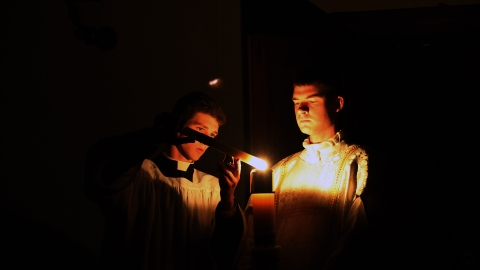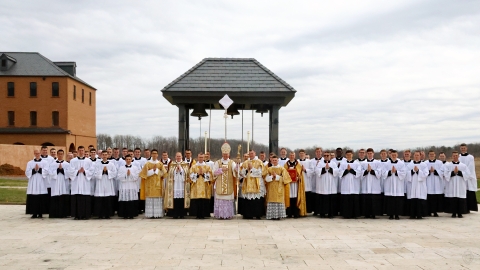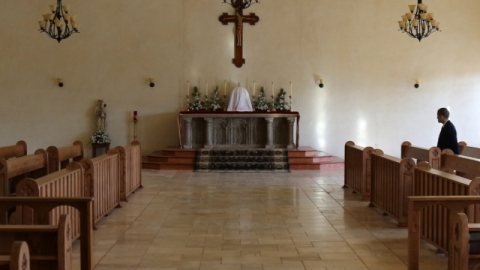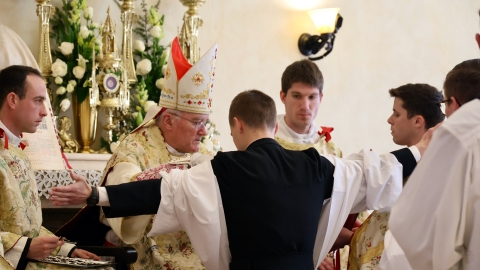1988: SSPX Seminary Moves to Winona, MN

Seminarians relate in the Winona Diary the first events following the move of St. Thomas Seminary from Ridgefield, CT to its new location in Winona, MN in 1988.
It was June 22 and Fr. Bourmaud had just arrived in Winona with the first large contingent of seminarians. This group was assigned to help with the seminary renovation project and to prepare for the Summer Boys' Retreat Camp.
That following Sunday, after having been banished from His tabernacle some eighteen years ago, Our Divine Lord returned victorious at the hands of Fr. Bourmaud who celebrated Mass on the seminary chapel's main altar. Four days later, with our Father Rector being consecrated Bishop in Ecône, our crew on Stockton Hill attracted local and national media interest.
The seminarians' mission: help to make the seminary function for thirty by August 1 (in time for the thirty-day Ignatian Retreat) and for seventy by September 1, the start of the new term. We arrived to find that "P. Sardegna and Sons & Co." and an elite corps of volunteers had completed the bulk of the restoration work....
A series of ordinations began on October 1, when eighteen seminarians were officially tonsured, and another nine were ordained to Minor Orders of Porter and Lector. If His Excellency Richard Williamson is a clerical "son" of Archbishop Lefebvre, then these were His Grace's first clerical "grandchildren." On Friday next, another nine were ordained Porter and Lector and an additional nine received Orders of Acolyte and Exorcist.
The Saturday following, some three hundred joined us to see Bishop Williamson dedicate the seminary chapel and celebrate a Pontifical High Mass in which sermon he called upon the best of America's young men and women to enlist their blood in the "War of God" for Truth and to learn love for "the house of the Lord."
On the Feast of All Saints, seven seminarians were ordained Subdeacons, and became (in the words of the ordination rite): "...tireless and watchful sentinels of the heavenly army in Thy holy sanctuary." The rite was heavy with holy symbolism. Over each ordinand's head the amice was drawn by the bishop, signifying the control of the tongue; their reception of the maniple meant God's claim to the fruit of their good works. Invested with the dalmatic, each stood before God, heralds girt with new powers—"clothed with beauty... and strength"—pre-figuring by this first of the Major Orders their approaching honor as alter Christi. That afternoon, twenty received the Sacrament of Confirmation....
How does the St. Thomas Aquinas of Winona differ from that of Ridgefield? Noticeably, this is a seminary! Ridgefield, though serving nobly for nine years, was a double-conversion; first from a residence, then from a former Jesuit retreat house. Our new home is a veritable fortress of the Faith. The Dominicans took no half-measures in its building. Its walls reflect the invincibility of the Truth taught within them.
In our more spacious Winona quarters, more organized work can be done faster. But, the increased physical size demands more maintenance, and that translates into a new twenty-five page house job "manual" which details the daily seminarian work tasks necessary for smooth operation.
We remember fondly the catacomb basement chapel in Ridgefield. There was that intimacy of being so close—even in the pews—to that tabernacle before which there had been cassocks taken, vows and engagements made, so many meditations and rosaries prayed. But, we also remember its back sacristy, overcrowded at each ceremony with ministers or seminarians or faithful, or our bookstore display or all of the above simultaneously!
The main chapel in Winona spares nothing to the King of Kings. The roof vaults upward in wood from walls of handsome travertine stone. The main altar rises from a jasper-colored predella back-dropped by a majestic twelve-foot crucifix on a facade of rose- and bronze-striated marble. A gold medallion of Our Lady, Queen of the Clergy, is centered in the altar's front face. (Two sacristies flank the sanctuary and two more storage rooms are on the second floor.) A sixty-foot aisle from the sanctuary to the rear entrance door allow the grand processions ascending to the altar that the Ridgefield chapel was too small for. Fourteen figures in stained glass watch from either side, among them Our Lord, His Blessed Mother, St. Jude Thaddeus, and eleven Dominican saints (among them St. Thomas Aquinas). The rising sun sets them on brilliant, blinding fire, transfiguring each crystal saint with gleaming, glorified bodies. Here, our chant rolls and echoes prayerfully with a monasterial timbre....
In the words of Superior General Fr. Schmidberger, this is "the most important building in North America." North America is missionary country and here, now, in her heartland, we train, by the grace of God, to be her missionaries.
Source: The Angelus – December 1988





